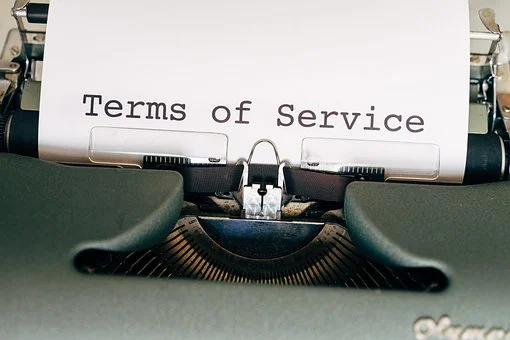Table of Contents
Terms and Conditions for Business

A term we usually come across before using any service, online and offline. We typically skip advertisements when the sponsor talks about the terms and sometimes tick the boxes to get over the process when signing up for a service. However, these terms and conditions are essential for building a business. These terms can determine the users’ limits to use a service and hold power to revoke a customer’s usage. Let’s dive further into the topic and explore the general conditions applicable when signing up for a service.
Terms of Service

Terms of Service (Terms & Conditions, End-User Agreement, Terms of Use, Legal Notes) are the official terms of a legal agreement between a service provider and a user. The user must agree to these conditions to use the service of a provider. These terms can merely be a disclaimer or contain many other requirements to which you must agree before signing up for a service. These conditions are the rules of conduct for your site and will protect you and your customers from any mishap through the use of the website.
Having these terms and conditions for business is not mandatory but undoubtedly advisable. These conditions can protect your site by banning the use of specific users who could abuse your app or its services. There is no set format to draw up the clauses for conditions; they can all be your own, except for some mandatory provisions such as privacy policy. The service provider can use these conditions on websites, blogs, e-commerce sites, mobile apps, social media, transport services, etc.
Purpose of Terms & Conditions

The Terms and Conditions are the documents that assist in dealing with problems or preventing them from occurring in the first place. As a result, the Terms and Conditions are critical to mounting an adequate and proper defense in many cases. This will make your company appear more professional and trustworthy, but it will also give you more control over how your users interact with your platforms and content.
For example, if anyone violates your site, app, intellectual property, or any other reason outlined in your website terms and conditions, you gain legal grounds to exclude or terminate them. In a nutshell, it protects you and provides you with legal recourse if someone causes a dispute.
What To Include in Terms & Conditions

As we have mentioned above, each term and condition of a company is unique and entirely dependent on the company’s services. Therefore, the keywords should be considered after a careful review as there should be no loopholes to be ignored. You can add up to innumerable clauses, but you need to understand the clauses and pick them related to your service. If you’re a beginner, it’s good to look at similar e-commerce websites to understand these terms. Below are some examples of the general clauses added under terms and conditions.
Conditions of Use
These are also under the general conditions or online store terms of use. It states that the users are not allowed to steal or plagiarise their services and will not unlawfully violate any terms. You should also include that the service provider can amend these terms and conditions based on the service updates.
Example
- You agree not to reproduce, duplicate, copy, sell, resell or exploit any portion of the service, use of the services, or access to the services without the express written permission of Shopify.
- You agree not to access the services or monitor any material or information from the services using any robot, spider, scraper, or other automated means.
Privacy Disclaimer
The privacy disclaimer clause will inform users that they agree to your Privacy Policy by using your website. It will frequently include handling private information, collecting that information, and managing cookies. Many websites link their privacy policy instead of the entire clause, which is okay as few users would like to go through the website.
Example – Bikayi explains its privacy policy and clearly describes the types of data they have access to and its terms of use.
Welcome to Bikayi. Comida Technologies Private Limited (“us”, “we”, or “our”) operates the bikayi.com website and the Bikayi mobile application/”Service”). Our Privacy Policy explains how we collect, use, disclose, and protect information that applies to our service and your choices about collecting and using your data. This policy sets out how Bikayi collects and uses the information we collect about you when you use Bikayi services. This policy also explains the choices you can make about how we use your data.
Intellectual Property
This section is similar to the copyright clause, and it explains that users cannot exploit or copy your content for their personal uses. If you have user-uploaded content, you can specify what belongs to the users and what doesn’t. This clause protects your media content, blog, photos, videos, logos, etc.
Example
We don’t allow apps or developer accounts that infringe on the intellectual property rights of others (including trademark, copyright, patent, trade secret, and other proprietary rights). We also don’t allow apps that encourage or induce infringement of intellectual property rights.
Limitation of Liability
The Limitation of Liability section is critical. This is where you state unequivocally that your company will not be held liable for damages that occur before, during, or after a transaction, or that result from theft, breaking the law or violating the Terms and Conditions agreement.
Example
The Distributor shall have no liability to compensate the company for any claim pressed by the latter under this agreement except as expressly provided. The Agent shall not be liable or responsible for any action taken or omitted by him in pursuance of this agreement in good faith, except for gross negligence, bad faith, or willful misconduct adjudicated by a court of competent jurisdiction.
Payment Terms
The payment terms section specifies the methods of payment that users can use to make a purchase. If you give your users the option, you can also include financing information. You can also add all your details about delivery fees, shipping monetary values, GST taxes, etc., under this section.
Example
Customers shall pay all fees outlined in each applicable Order Form within thirty (30) days of the invoice date in a suitable Order Form or SOW. Customer may withhold payment of any Fees that are the subject of a good faith dispute of which Customer has provided written notice within five (5) business days of invoice receipt (“Disputed Fees”)
Termination Clause
This clause gives you the authority to terminate any account or user if they violate your terms and conditions. You can also include how your customers can close or cancel their accounts and the rules that apply. You can add steps describing the action taken to your account when they terminate or cancel it.
Example
Within thirty (30) days after the effective date of termination, Sprinklr will, upon the customer’s request, extract all available customer content from the platform. If customer accounts get deactivated before the termination date, data contained within those accounts is no longer available; therefore, customers must extract the data before deactivating accounts. After such a thirty (30) day period, Sprinklr shall have no obligation to maintain or return any customer content.
Other Related Clauses
- Governing Law – The Governing Law clause will inform users about the agreement’s laws. These laws should be enacted in the country where your company’s headquarters are or where you operate your website and mobile app.
- Third-Party Links – This clause informs users that you are not responsible for any third-party websites you link. In general, this type of clause will notify users that they are solely responsible for reading and agreeing (or disagreeing) with these third parties Terms and Conditions or Privacy Policies.
- Return Policy – In case you’re an e-commerce business or any retail service, this clause touches on the details of the return business of a product and its process.
How To Present These Terms & Conditions?

Most websites use the browse wrap method to present the terms and conditions at the bottom of the page. Here, you agree to the terms of service just by browsing through the website; no affirmation is needed.
The other method of presenting is through clickwrap. Clickwrap is when you force your users to take action by usually clicking something – to show that they agree. But while using this method, you must make sure that the terms and conditions page is available through a link for immediate access.
The terms and conditions document is a legally binding contract intended to protect you, the business owner. Hence, it is critical to match your specific business processes and model and remain current with the various laws referenced in its contents. These have to be written in a detailed and authentic manner to ensure easy reading and understanding for the users.













